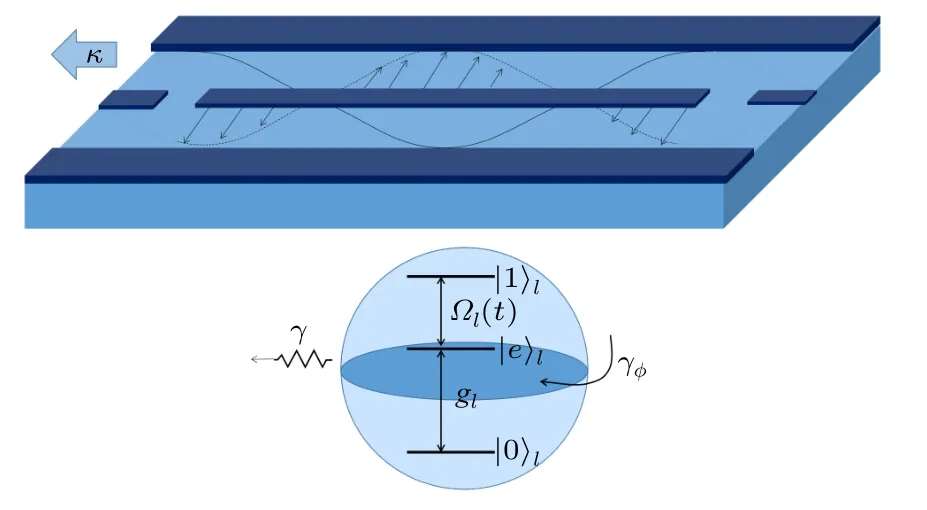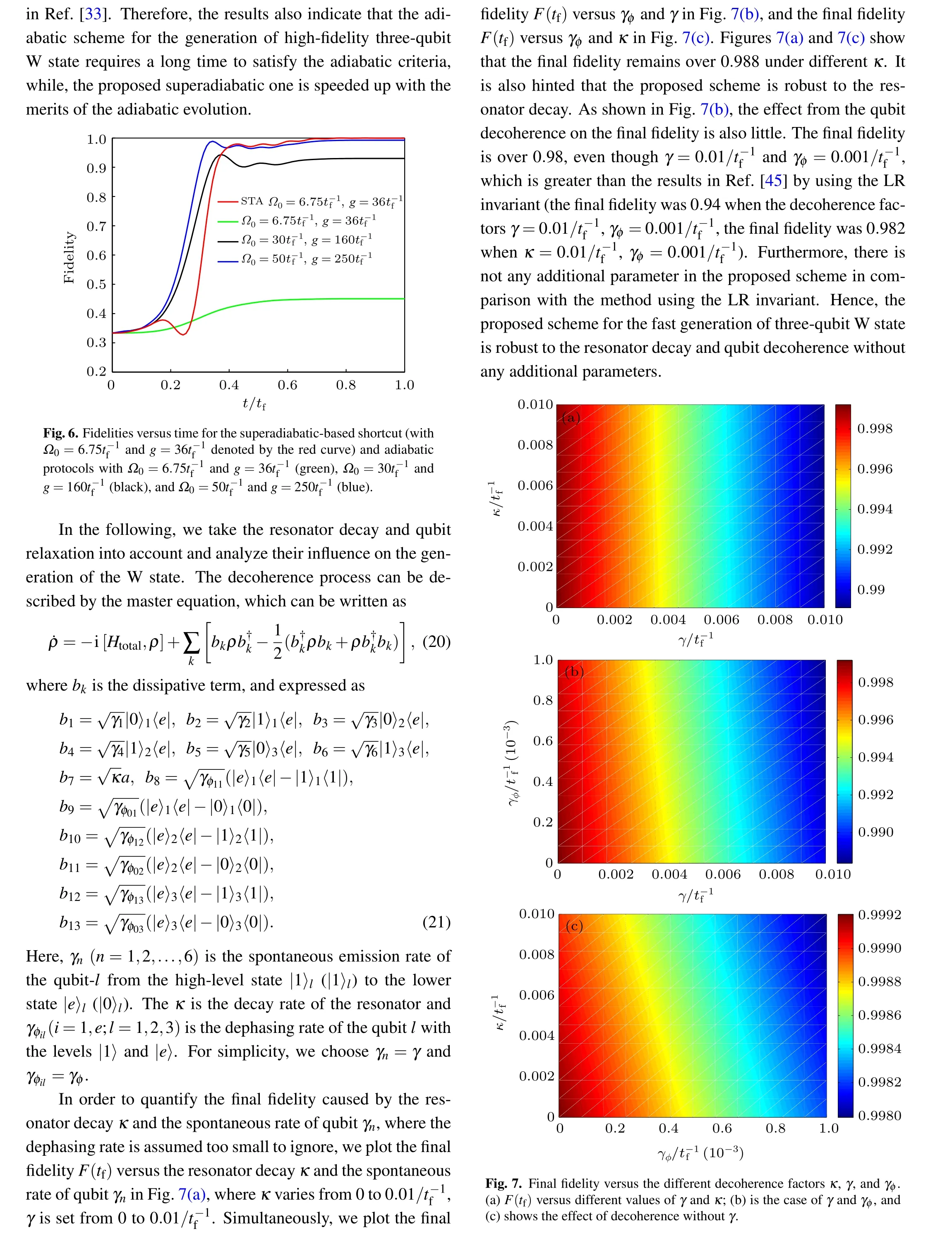Fast generation of W state via superadiabatic-based shortcut in circuit quantum electrodynamics?
Xue-Mei Wang(王雪梅), An-Qi Zhang(張安琪), Peng Xu(許鵬), and Sheng-Mei Zhao(趙生妹)
Institute of Signal Processing and Transmission,Nanjing University of Posts and Telecommunications,Nanjing 210003,China
Keywords: W state,superadiabatic-based shortcut,circuit quantum electrodynamics
1. Introduction
During the development of quantum communication and quantum computation, quantum entanglement plays an increasingly important role in quantum information processing. Correspondingly, the generation of entanglement states has also been widely investigated in literature both theoretically[1-16]and experimentally.[17-19]For multi-particle entanglement, there are two major types of entangled states,the W states and the Greenberger-Horne-Zeilinger (GHZ)states. They can not be converted to each other by local operations and classical communications. The W states of three or multi-particle are more stable when one of the particles is lost. Additionally, the W states are robust to the global dephasing and bit flip noises. Therefore,the W states have been widely exploited in quantum key distribution(QKD),quantum teleportation,quantum conversation,etc.[20-27]
Till now,the preparation of W states was demonstrated in different physical systems,such as,the ion trap system,[28]the cavity quantum electrodynamics (cavity QED),[29,30]circuit quantum electrodynamics(circuit QED),[31,32]and many other physical systems.[33,34]In different physical systems, due to their different devices and protocols,the time taken to prepare W states is also very different. Among them, the time used to prepare W state in Rydberg atomic system is 0.6 μs.[33]Among the different physical systems, the circuit QED has become the promising candidate due to its long coherent time,easily being coupled with other physical system and scaled up to large scale. In the circuit QED,the widely used qubit is the superconducting transmon qubit.[35,36]Compared with the superconducting charge qubit, the transmon qubit is immune to charge noise,and has a longer coherent time.
Many evolution processes to prepare the W states followed the adiabatic passage,[37-39]so that they required a long enough time to meet the adiabatic condition, which severely limits the applications of the W states in quantum information processing. One possible way to overcome the above drawback is the shortcut to adiabatic passage.[40-45]Several schemes have been proposed for the generation of the W states via the shortcut adiabatic passage.For example,Kang et al.[46]proposed a scheme for the fast preparation of W state with the superconducting quantum interference devices by choosing a set of dressed states suitably,which could be used to accelerate the adiabatic passage with an auxiliary qubit. On the other hand, Yu et al.[47]prepared the W states of three superconducting qubits via Lewis-Riesenfeld (LR) invariants, which needed an additional parameter and made it difficult to realize in experiment.
In this paper,we propose a simple scheme to achieve the fast generation of three-qubit W state based on the circuit QED system via the superadiabatic-based shortcut. First, the effective Hamiltonian is obtained by unitary transformation and supposed to ignore the high frequency term. Then, two iterations are carried out to obtain the counterdiabatic driving for suppressing the unwanted transitions between the different eigenstates for acceleration. Finally, the W state is achieved through the superadiabatic passage with high-fidelity. In addition, the pulse form in the Hamiltonian is designed to be replaced by the alternative superpositions of Gaussian pulses for the feasibility. And the performance of the proposed scheme is discussed by numerical simulations.
The paper is organized as follows. Section 2 presents the physical model based on the circuit QED system,and an effective Hamiltonian is deduced to realize the fast generation of the three-qubit high-fidelity W state. In Section 3,we describe the superadiabatic scheme and investigate the conditions for the fast generation of W state analytically. In Section 4, numerical simulations are performed with selectively controllable parameters which prove that the protocol is feasible. Finally,conclusions are given in Section 5.
2. Physical model and effective dynamics
We consider a superconducting architecture where three identical transmon qubits are fabricated in a transmission line resonator. Figure 1 shows the schematic diagram of the superconducting architecture,including the circuit QED and the energy-level of the transmon qubit. All the qubits are truncated to three-level, i.e., |0〉l, |e〉l, |1〉l, here, |e〉lis an auxiliary state,and the subscript l=1,2,3 label different transmon qubits. The information is encoded on the states|0〉land|1〉l.The transition between states |0〉land |e〉lis resonantly coupled to the resonator with coupling strength gl. And states|1〉land |e〉lare resonantly driven by a classical pulse with timedependent Rabi frequency Ωl(t).Both the qubit-resonator and qubit-pulse are considered on one-photon resonance and the|0〉l?|1〉ltransition is forbidden.

Fig.1. The schematic diagram of the superconducting architecture,including the circuit QED and the energy-level of the transmon qubit.The κ is the decay rete of the resonator.The γ and γφ denote the spontaneous emission rate and the dephasing rate of the qubit,respectively.


where ωris the frequency of the resonator, and a (a?) is the associated annihilation (creation) operator for the resonator.Under the rotating-wave approximation, the effective Hamiltonian of the circuit QED system can be described as


Assume that the system is initialized on the state|0〉c|1〉1|0〉2|0〉3, where the resonator is in the vacuum state|0〉, the qubit-1 is prepared in the state |1〉, and the qubits 2 and 3 are in the ground state |0〉. According to the effective Hamiltonian,the system evolves in a subspace spanned by the following seven bases:






5. Conclusion
We have proposed a scheme to prepare the high-fidelity three-qubit W state via superadiabatic-based shortcut. In order to suppress the transitions between different instantaneous eigenstates, the counterdiabatic Hamiltonian with the same form as the effective Hamiltonian has been obtained for the easily implementation in experiment. Additionally, the intricately driven pulses have been replaced by the Gaussian pulses which is feasible experimentally. The numerical results show that the time evolution for the proposed scheme has been significantly speeded up, and the proposed scheme is robust against the decoherence caused by the resonator decay and the spontaneous emission and dephasing of qubit. Compared with the adiabatic case, the proposed protocol could prepare the entanglement state within a very short time. Meantime, it is found that our result can be extended to the case of multiplequbit W state,especially the odd-number qubit W state.
- Chinese Physics B的其它文章
- Nonlocal advantage of quantum coherence in a dephasing channel with memory?
- New DDSCR structure with high holding voltage for robust ESD applications?
- Nonlinear photoncurrent in transition metal dichalcogenide with warping term under illuminating of light?
- Modeling and analysis of car-following behavior considering backward-looking effect?
- DFT study of solvation of Li+/Na+in fluoroethylene carbonate/vinylene carbonate/ethylene sulfite solvents for lithium/sodium-based battery?
- Multi-layer structures including zigzag sculptured thin films for corrosion protection of AISI 304 stainless steel?

